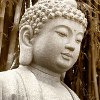
The fact that we do not have a well-developed science of happiness today is really quite bizarre. We have an embryonic start in positive psychology, but why weren’t scientists studying happiness from the beginning, when Copernicus was studying the stars?
Of course, medical doctors are doing a pretty good job of understanding the physical causes of happiness and suffering. But a science of happiness focused on its mental causes is not very evident, particularly concerning the means for improving the lives of people who are not mentally disabled.
This lack was demonstrated vividly in 1989, when the Dalai Lama met in California with a group of mind scientists, including a psychiatrist, a philosopher, and several neurophysiologists and cognitive psychologists. The psychiatrist spoke with great satisfaction about the treatment of depression using many different drugs, with more being developed. He described the usefulness of these drugs in controlling the symptoms of depression.
Then the Dalai Lama asked, “Depression may arise for a wide variety of reasons, including a chemical imbalance in the brain, diet, lifestyle, or an angry mind. It could be due to the loss of a loved one. It might not even be personal, but could arise from despair over the state of the world. How do you account for the diverse causes of depression when you prescribe these medications?”
The psychiatrist answered, “It doesn’t matter. The drugs work regardless of the causes.” He was not suggesting that any of these medicines actually cure depression. Professionals in the field use the phrase “managing symptoms,” which might be more accurately called “suppressing symptoms.”
This strikes me as rather primitive. Of course, many brilliant psychoanalysts and therapists investigate the causes of depression and actually heal people. But drugs alone usually fail to produce a full cure.
Identifying the True Sources of Happiness or Unhappiness
The central themes of cognitive balance are to recognize the nature of impermanence, differentiate a true source of happiness or unhappiness from a mere catalyst, and fathom the true nature of existence. By realizing what we are not, we will understand how we actually exist instead of misconstruing our inherent existence. Sometimes it seems that cognitive imbalance dominates our lives.
Tremendous suffering comes from grasping on to relationships, people, and things as more robust and enduring than they really are. We mistake actual sources of suffering for happiness and mistake actual sources of happiness for suffering. We reify the self and bifurcate ourselves from others, creating the radical isolation in which all religious, national, and ethnic conflicts are rooted. In cultivating cognitive balance as a foundation for vipashyana practice, our focus is on restoring balance in these three domains of reality.
As important as these three themes are, the Mahayana teachings on the perfection of wisdom transcend them to address the universal nature of our conceptual projections. All events and phenomena are explained as dependently related events — nothing exists independently, isolated from the rest of reality. In the process of reifying, we substantiate and project tangibility onto phenomena that have no existence in and of themselves. Every individual and every phenomenon in the world arises as a dependently related event in an ocean of interrelationships.
The Teachings of the Buddha
 The importance of cognitive balance, within which there are various levels, is not a sectarian issue. The teachings of the Buddha, as recorded in the earliest accounts of the Pali Canon, clearly show precursors of the teachings on Madhyamaka, the Middle Way view. Some schools of Buddhism highlight certain facets more than other traditions do. I am delighted to be living in this era, with access to the Zen tradition, which has some unique excellences. The Chan, Japanese, and Korean traditions illuminate certain aspects of the Buddha’s teachings in marvelous and unprecedented ways. The Theravadins developed mindfulness of the breath and the four close applications of mindfulness with exceptional richness—these are key strengths. The teachings preserved and highlighted in the Tibetan tradition are utterly extraordinary, not to mention the rest of the world’s contemplative traditions.
The importance of cognitive balance, within which there are various levels, is not a sectarian issue. The teachings of the Buddha, as recorded in the earliest accounts of the Pali Canon, clearly show precursors of the teachings on Madhyamaka, the Middle Way view. Some schools of Buddhism highlight certain facets more than other traditions do. I am delighted to be living in this era, with access to the Zen tradition, which has some unique excellences. The Chan, Japanese, and Korean traditions illuminate certain aspects of the Buddha’s teachings in marvelous and unprecedented ways. The Theravadins developed mindfulness of the breath and the four close applications of mindfulness with exceptional richness—these are key strengths. The teachings preserved and highlighted in the Tibetan tradition are utterly extraordinary, not to mention the rest of the world’s contemplative traditions.
Of course we can look beyond Buddhism, but it is not practical to follow all religions simultaneously. We must follow a path that genuinely appeals to us, nourishes us, and benefits us. I’m happy to follow my own path as far as it can possibly take me. At the same time, I look at my Taoist brothers and sisters with great admiration. Vedantists, Sufis, Christians, and Jews possess ancient legacies with very rich traditions. By appreciating these traditions, one can occasionally draw from teachings that are compatible with one’s own path — this is immensely rewarding. For example, I love co-teaching with Laurence Freeman, a Benedictine monk. He’s a very devout Christian, and I have learned much from him. We learn from each other in ways that are completely compatible with our respective paths.
Living in today’s world, we can rejoice in our historically unprecedented access to a wealth of contemplative wisdom from multiple cultures. While remaining true to our own tradition, we can savor the special qualities that are illuminated with clarity and depth in other traditions. The Buddha himself taught the four close applications of mindfulness as a phenomenological investigation of the constituents of immediate experience. Even the Tibetan tradition includes nothing quite like the mindfulness practices in the Pali Canon and the Theravadin commentaries. These are the clearest, most practical presentations I have seen, and they are unquestionably grounded in experience. I am very grateful to my teachers from the Theravadin tradition for maintaining and transmitting these exceptional practices.
©2011. All rights reserved.
Reprinted with permission of the publisher,
Snow Lion Publications. www.snowlionpub.com.
Article Source
Minding Closely: The Four Applications of Mindfulness
by B. Alan Wallace.
 Bringing his experience as a monk, scientist, and contemplative, Alan Wallace offers a rich synthesis of Eastern and Western traditions along with a comprehensive range of meditation practices interwoven throughout the text. The guided meditations are systematically presented, beginning with very basic instructions, which are then gradually built upon as one gains increasing familiarity with the practice.
Bringing his experience as a monk, scientist, and contemplative, Alan Wallace offers a rich synthesis of Eastern and Western traditions along with a comprehensive range of meditation practices interwoven throughout the text. The guided meditations are systematically presented, beginning with very basic instructions, which are then gradually built upon as one gains increasing familiarity with the practice.
Click here for more info or to order this book on Amazon.
About the Author
Trained for ten years in Buddhist monasteries in India and Switzerland, Alan Wallace has taught Buddhist theory and practice in Europe and America since 1976. After graduating summa cum laude from Amherst College, where he studied physics and the philosophy of science, he earned a doctorate in religious studies at Stanford University. He has edited, translated, authored, or contributed to more than thirty books on Tibetan Buddhism, medicine, language, and culture, as well as the interface between religion and science. He teaches in the Department of Religious Studies at the University of California, Santa Barbara, where he is launching one program in Tibetan Buddhist studies and another in science and religion. Alan is the president of the Santa Barbara Institute for the Interdisciplinary Study of Consciousness (http://sbinstitute.com). For information about Alan Wallace, visit his website at www.alanwallace.org.





























